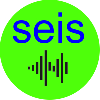Geophysical Methods
exploration, near surface and marine methods
Seismology |
Seismic exploration |
Seismic source |
Seismic Refraction |
Seismic Reflection |
Seismic MASW-REMI |
Borehole |
Marine Seismic |
Seismic Processing-Imaging |

Marine Seismic
Marine acquisition of seismic reflection data is generally accomplished using large ships with multiple airgun arrays for sources. Airguns are deployed behind the seismic vessel and generate a seismic signal by forcing highly pressurized air into the water. Receivers are towed behind the ship in long streamers that are several kilometers in length. Marine receivers are composed of piezoelectric hydrophones, which respond to changes in water pressure. Being pressure sensitive, hydrophones measure the acceleration of the medium as a seismic wave passes through it, unlike geophones, which respond to the velocity of the medium. Because of sensitivity and noise issues, responses from a group of 5 to 50 hydrophones are summed to produce a single seismogram, and the group is considered a single receiver. Note that the equipment just described is generally intended for probing subsurface depths of a few hundred meters to 10 kilometers. Marine seismic acquisition is also performed for shallow hazard surveys using smaller ships, higher frequency sources and much shorter hydrophone streamers, frequently with only a single receiver group. Marine Seismic Acquisition Technologies for enhanced reservoir delineation, characterization, and monitoring. Towed-streamer acquisition technology : Q-Marine point-receiver marine seismic system and recently the IsoMetrix marine isometric seismic technology consisting of incorporates multimeasurements to 3D seismic processing and imaging. Acquisition solutions also includes nodal and cabled seabed options as well as autonomous seismic acquisition technology. Marine Seismic Acquisition Techniques: high level of subsurface illumination and rendering. Coil Shooting and Dual Coil Shooting: record data while traveling in continuous circles for a more complete view of the subsurface from every angle without non-productive intervals for line changes. Wide-Azimuth Marine Acquisition: illuminate complex reservoirs using advanced seismic acquisition techniques that greatly improve the signal-to-noise ratio. Broadband Acquisition: Maximize the usable seismic signal across the full-frequency spectrum using our broadband acquisition technologies and techniques. IsoMetrix Marine Isometric Seismic Technology | Delta Calibrated Marine Broadband Seismic Source Efficient Acquisition Designs. CLA Continuous Line Acquisition Method | SimSource Simultaneous Seismic Source Acquisition & Processing Technique Time-Lapse Marine (4D) Acquisition Marine Seismic: Define sub-bottom features and map subsurface layers beneath water. Applications include: river crossings (i.e. horizontal drilling), pier and caisson construction and mineral exploration. Marine Multi-beam: Define subsurface hazards and marine construction impediments. Transducer and marine magnetometers can prove a cost effective survey technique to map sediments and define utility locations.PASTE RESPONSIVE AD
Recent advances in acquisition technology are improving the quality and economics of 3-D acquisition. In land acquisition, the logistics of deploying receiver stations and cables are a significant expense, severely limiting the number of receivers that can be deployed per shot. Thanks to advances in electronics, the receiver signal is now commonly digitized at or near the receiver, and the data are either recorded near the receiver stations during a survey, or transmitted to a base station by radio or by fiber-optic cables. This improvement in data handling makes it economical to deploy more receivers during a survey. In marine surveys, the streamer mode of acquisition has traditionally allowed only nearly "in-line" source-receiver azimuths and provided only limited angular raypath coverage of the subsurface. Today, seismic vessels can deploy a number of streamers behind the ship in parallel -- as many as 20 -- allowing the acquisition of a wider azimuth of source-receiver offsets and making it possible to acquire more data in a fixed amount of time. Another new development in marine acquisition is the deployment of multiple vertical cables, each anchored at the seafloor bottom and containing multiple receivers. As the source ship shoots around and over the vertical cable deployment, data are acquired with multiple source-receiver offsets and receivers at multiple depths. The variety of receiver depths beneath the water surface makes the elimination of water surface multiples a simple task during subsequent data processing.
An important subset of reflection seismology is multi-component seismology. Multi-component seismic acquisition has recently been transformed by new technological developments that have improved the practicality of marine acquisition. In the solid earth, the complete elastic wavefield is composed of both P-waves and S-waves and is a vector quantity. Multi-component receivers that measure particle displacements in three perpendicular orientations are necessary, therefore, to detect the full elastic wavefield. In a marine environment, however, water cannot transmit shear wave energy, so direct recording of multi-component information is not possible using towed streamers. Marine multi-component acquisition is feasible using ocean bottom seismograms (OBS's), but placing individual multi-component receivers on the sea floor is time consuming and expensive. These practical constraints on ocean bottom acquisition have recently been addressed by the development of cables containing multi-component arrays that can be deployed on the sea floor more economically. This advance in acquisition technique has been matched by the recent appreciation of the importance of converted mode energy in reflection seismology. Although marine seismic airguns generate only P-wave energy, some portion of the P-wave energy is converted into S-wave energy as the direct wave travels downward into the subsurface and encounters impedance boundaries. The converted mode corresponding to conversion upon reflection from down-going P-wave to up-going S-wave is sometimes referred to as the C-wave, and is now known to have practical applications in exploration. Multi-component seismic data are discussed further in the section on seismic interpretation.
PASTE RESPONSIVE AD